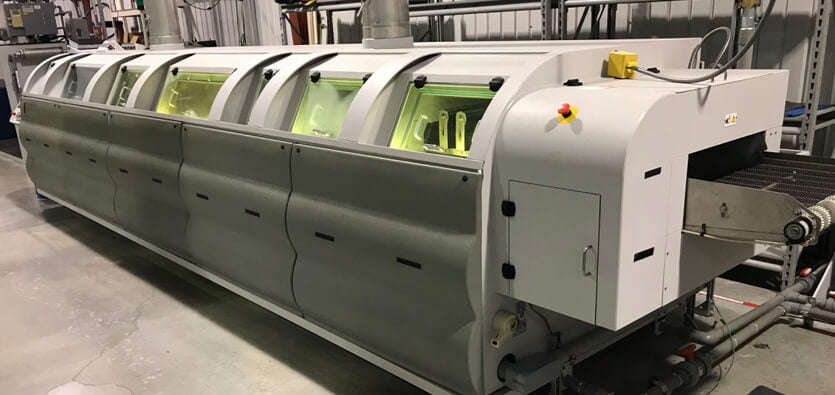
Aqueous cleaning incorporates water as its primary dissolving agent. Adjusting the pH levels of aqueous solutions helps in removing distinctive substances from different surfaces on industrial equipment. Acidic aqueous solutions can better remove rust, scale, and oxides from metals, while soluble aqueous solutions can remove oxides, salts, metal chips, natural soils and oil effectively.
The use of water-based cleaners depends on the type of application and other considerations such as budget and time constraints, tools and personnel availability, quality requirements, and maintenance. The following are six significant factors impacting aqueous cleaning results:
Agitation
The physical action of moving the contaminated part in a cleaning solution is called agitation. There are different ways to accomplish this depending on the setup available, geometry and arrangement of a part, and kind of soil being removed. The main techniques used in agitation are as follows:
- Soaking involves placing a part that needs to be cleaned in a bath of cleaning solution for some time to remove any soils
- Hand Wiping involves scrubbing of a part utilizing a solvent and a brush
- Spraying involves removing soils from parts with the help of automated sprays of cleaning solution
- Ultrasonic cleaning involves removing dirt from parts using sound waves
Some of the advantages of agitation include breaking up soil molecules, moving soil away from parts, enhancing wash efficiency, and decreasing wash time. Some of the disadvantages of agitation include the limited type of equipment availability, damaging delicate elements, and specialty plating, and enhanced equipment cost and maintenance needs.
Chemistry
The type of cleaner used significantly affects how aggressively soil is removed from a contaminated area. It can either be a simple solution of soap and water or a complex solution containing different qualified cleaning chemicals. The ingredients used in producing a cleaner depend mainly on the condition of the surface, the material of a part or area, soil, and cleaning method. Overall, chemicals utilized in a cleaning solution include a base solvent, builders, additives, and surfactants.
Highly aggressive chemistry is required for effective cleaning while dealing with stable soils. Acid cleaners are more efficient against mineral scale, while caustic cleaners are more useful against carbonized dirt and heavy grease.
Temperature
Overall, higher temperatures yield better cleaning results as compared to lower temperatures. That’s because each step of the cleaning procedure occurs easier and faster as temperatures increase. From a chemical standpoint, reactions between solutions and soils occur at faster rates.
As temperature rises, the viscosity of soil reduces, allowing aggressive cleaners to penetrate through the soil more easily. However, the enhanced temperature is also harmful to a part surface, allowing etching or corrosion at a faster rate.
Time
The results of specific cleaning processes depend primarily on the amount of time spent on cleaning. More significant cleaning times generally tend to learn toward surfaces and areas which require more attention. This means that the longer a part is scrubbed or sprayed, the longer the chemicals have to act on soils to remove them from a particular surface.
However, companies cannot afford to spend too much time cleaning as it leads to an increase in their overhead and labor costs. To overcome this issue, high-quality industrial cleaners with aggressive chemicals can be used for effective cleaning results.
Rinsing
A sufficient amount of rinsing is needed to not only get rid of soil but also the cleaner to avoid residues. While using an aqueous solution, a proper rinse is crucial for accomplishing comprehensive cleaning of the parts or areas. Some of the benefits of rinsing include removing chemical residue and surface oil, preparing a surface for the next manufacturing step, and protecting parts by adding a corrosion inhibitor to rinse water.
Drying
Water left on any surface can result in corrosion or interrupt post-cleaning procedures, which is why the importance of drying shouldn’t be ignored. Drying the part is just as important to accomplish good cleaning as other steps, especially before NDT inspections. Some of the advantages of drying include preventing parts corrosion, eliminating water residue, and keeping the surface clean.
Sunrise Industrial Cleaners produces different types of industrial-grade cleaning products. Visit our website to explore our high-quality products or contact us for customized care.
